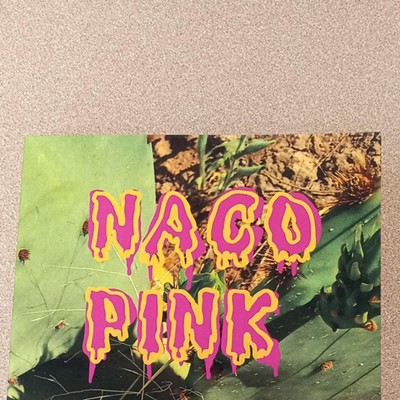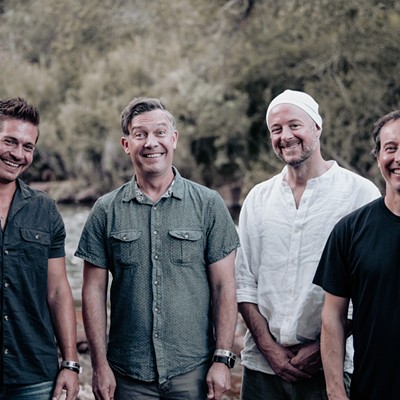It's a starry night on the Devil's Highway.
A thousand points of light twinkle against the velvet-black sky. The horizon is barely visible, but if you look long enough you can see the low mountains reaching their jagged peaks into the sky.
A surprising glow comes from the desert floor at left, casting an orange light on ocotillos and saguaros. It's electric light coming from a Border Patrol camp.
Photographer Mark Klett captured the agents aiming floodlights at the Camino del Diablo, a remote trail in southwest Arizona that over the centuries has claimed many lives. Where once it was soldiers, missionaries and explorers who perished out there, now migrants are doing the dying.
The agents, unseen in the photo, are "cutting sign," using old-time scout techniques to track the footprints of desperate border crossers. Working in a vast wilderness, black sky above and dark desert below, they're conducting a nearly impossible task, searching for those who don't want to be found.
Klett's "Border Patrol `cutting sign' near midnight, Camino del Diablo," 2013, serves as a moody introduction to Into the Night: Modern and Contemporary Art and the Nocturne Tradition. A sensuous and poetic exhibition at the Tucson Museum of Art, the show is an homage to the night, rendered in photographs, paintings and works on paper created by more than 65 artists.
Dr. Julie Sasse, the museum's energetic chief curator, sought out nocturnal art that explores the darkness, in all its literal and metaphorical dimensions. Many of the pieces are drawn from the museum's own holdings.
There's a magic to the work she chose. A dancing spiral of flames breaks the darkness in Stu Jenks' enchanting "Catalina State Park," a 1999 gelatin silver print. Painter DeAnn Melton's "Tucson, from Mount Lemmon," a 1990 oil on canvas, turns the nighttime city into an abstract waltz of tiny lights in white, amber and pale blue cavorting among thick bands of black paint. The longer you look at this merry nocturne, the more you see.
Other works embrace the mystery of darkness. In "Coyote," a large-scale Kate Breakey hand-painted photo, the animal has emerged from the shadows and turned its flame-yellow eyes toward the camera. In a few strokes of bright color, painter Jake Fischer, in his luscious oil "Truck on Maple," conjures up a house and a truck, but they're almost lost in a sea of black. The viewer becomes the stranger trying to imagine the hidden life that the darkness conceals.
And, of course, the night is about fear. Nightmares come alive in the darkest hours just before the dawn. Gonzalo Espinosa and Suzanne Klotz's "The Dreamer," a mixed-media painting from 1995, pictures a Mexican wrestler tied down with vines and trapped in a bed made of bones. It's like one of those nightmares where you can't move. As Espinosa writes in his artist statement, every night is a "little death."
Sasse looked back through the museum's own collections for early visions of the night. She found some big names, including Marsden Hartley and Georges Braque. Hartley was living in the south of France in a house that Cezanne once occupied when he painted "Olive Trees" in 1926. Emulating Cezanne's style, he made a night scene of undulating trees and bushes outlined in heavy black.
Braque was more playful. Working in 1963—the last year of his life, he dashed off a delightful aquatint, "La Nuit," a cheerful line drawing of a saucy moon and a sprinkling of stars.
Closer to home, Sasse found no fewer than eight Arizona aquatint/etchings by George Elbert Burr (1859-1939). These lovely works, dating from about 1905 to the late 1920s, capture the Southwestern landscape at the end of the day. "New Moon and Evening Star, Phoenix," circa 1928, pictures a crescent moon hanging in the pale sky of twilight with classic saguaros reaching upward. The hour is later in his "Arizona Night," from the 1920s. The mountains are black and the sky is charcoal gray; the light of the full moon falls everywhere.
Later artists give a contemporary twist to Burr's themes. Renowned photographer Richard Misrach's "Plate 46," from his 1976 Night Desert series, doesn't pretend, as Burr's does, that the land is pure and untouched, devoid of a human presence. In fact, Misrach emphasizes his own trespass into the desert. The sky is dead black but the photographer aims his car headlights at row of saguaros. We can see the cacti only through the intervention of human technology.
More recently, Scott B. Davis touched on desert tourism. His "Motel, Southern Arizona," 2007, illuminates a retro motel crumbling among the cacti. Using the antique technique of platinum/palladium printing, Davis deployed artificial light to record the boxy motel dwarfed two saguaros.
Painter Eric Nash's "Western Arrival," a 2015 oil on canvas, roars into the sprawl of Los Angeles. Black glossy sky takes up most of the big canvas, which itself sprawls along the wall: it's some 5 feet wide and 4 feet high. Amber light glows at the painting's low horizon and points of white light track the highways. The night can almost—but not quite—mitigate the environmental price paid by the City of Angels.
Sometimes the art is just about beauty, though. Mayme Kratz uses resin and weeds on board to create a vision of shooting stars in her "Map of Night," 2002. Klett likewise turns his gaze from human tragedy in the desert to the sheer beauty of the sky, in "Six quarter moons, 3/12/05," a shimmering split-toned gelatin silver print from his Time Studies series.
Jim Waid's 1992 oil on canvas "Oracle Night" was inspired by a moonlit walk through the artists' colony of Rancho Linda Vista. Like most of his works, this one luxuriates in the colors and forms of desert plants and birds and buzzing bugs, brightly painted into near-abstractions. This time around, though, into this glistening world he injects the silvery light of night.












